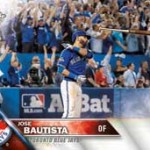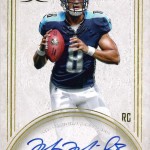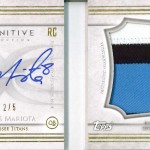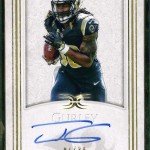Right now, a bunch of hobby industry professionals are in Hawaii talking about the business side of cards. For many, this is a trip to improve their business. Im sure there are many that need those lessons but cant go on an expensive trip. Let me tell you right now, the summit is all about lip service, and lip service helps no one. If you have read the recaps of the panels online, you will see that there isnt much offered there that cant be found online. I mean, you are reading a recap, right?
Dont get me wrong, networking is very important, but with every last person in the industry available on the internet to receive your questions and feedback, its not a big deal to talk to them face to face anymore. If you are personable online, many are more than willing to talk to you. I mean, is the Panini rep going to tell you something different just because you are in front of them? Guess what? The redemption program isnt going to change because you are there asking where your 2013 card is. Plus, if you really want to understand customers or talk to successful shops, there are thousands of potential customers and established retailers on twitter and facebook that can be engaged for feedback for free. No Hawaii trip required.
Moving on.
In my opinion, the population of individuals who visit hobby shops of any sort is dwindling. Not because of anything other than times are changing. The internet has changed the face of many hobbies to the point where they dont function anywhere close to the same as prior. The internet has changed our society, and that’s some toothpaste you cant put back in the tube. So, the question becomes, are hobby shops still necessary to the fabric of the hobby? I think the answer is more complicated than you might expect.
Im not going to get into the ins and outs of why shops should or shouldnt exist, because honestly I dont know enough about the marketplace to understand the true ripple effects of the last hobby shop closing its doors. I want to say that shops continue to be an ambassador to returning customers to the hobby, but im curious if google is more of an ambassador than anyone these days. My gut says yes.
Also, I have to mention that I am lucky. One of the best hobby shops in the country sits mere miles from my house, and I am a bit spoiled by the atmosphere that is on display. Sports Cards Plus recently underwent a large renovation sponsored by Panini, and now looks even nicer than it did before. That being said, a nice look isnt the only thing that keeps customers coming back. The owner, Charlie, takes an enormous amount of pride in the way his shop is run, and he is a student of his customers. Its uncanny.
That being said, there are some major and simple things that a shop can do to improve their position in the hobby world.
Curb Appeal
I get it, not everyone can set up in an upscale shopping mall, and some cant even afford to set up in a run down shopping mall. Margins in the industry are thinner than ever, and with the card companies constantly closing out product to every distributor with a pulse, the margins arent getting bigger. That being said, there are a lot of ways that someone can make their store look nice, even without a nice location. Whether its proper signage, updated window displays, or even just a big window into a clean store, Curb appeal is a huge deal. Its hard to continue to walk into a store that looks like a front for a drug operation. Because shop owners have a lot of control over “random” packs in their store, I have to have a level of trust to buy anything. If the curb appeal looks like a disaster, its hard to want to go inside.
Organization
The first judgement a card customer will make is the organization of your store. If things are strewn about and completely messy, you are not going to look good to a crowd that meticulously keeps their own collection as organized as possible. I get it, maintaining a clean store isnt easy when you are the only staff member, but if you want to grow your business, the inside has to be spotless. Cards need to be in boxes, packs need to be in boxes or bins, and everything needs to be straightened, dusted and kept out of the UV light. If you have a bargain area, make sure it is clearly labeled and separated from your premium stuff. Singles should be on shelves in a way that make sense, and though display cases can be expensive, they need to be a part of your setup. The outside of your shop can be a train wreck due to the area, but the inside needs to be a haven.
Customer Service
If you got into owning a store because you loved cards, you probably made the wrong decision. If you got into owning a store because you loved cards, and you love to serve your customers, its a bit different. Being a customer service rep means putting on a show. You have to be the reason your customers want to continue to buy from you. Chances are, many cities only have one or two shops. That means that competition is dwindling in that respect. What it SURELY doesnt mean is that competition doesnt exist. If you atmosphere sucks, because you are a dick or you dont pay attention to your customer’s needs, you will not get my business again. Ill just stay online. You are a facilitator and a salesperson, so you need to be exactly as available as I need you to be.
At a minimum:
- Greet every customer who comes in the door
- Be visible at all times – dont disappear into the back room
- Ask questions to determine what the purpose of my visit is
- Make suggestions
- Engage me in discussion / ask my opinion
- Show professional empathy and be respectful
- Dont sit on your computer
- Get feedback
- Dont treat me like a kid or a potential criminal
Customer service is an art, and if you are unable to come out of your introverted frame to really be “on” with your customers when they need it, good luck. The internet is not your biggest problem. Obviously, not every customer needs attention constantly, but you wont know the level they need until you talk to them. I cant count the number of times I walk into a store and see no one. No customers, no staff, nothing. Its tough to do everything by yourself, but that isnt always an excuse.
Setup of the Shop
Some shops are setup to be very pack and go. No areas to congregate, large rear of the shop to protect high value goods, and a lot of counters. Some stores are just small because they have to be. My personal preference is to have a display where wax and singles are available for purchase and an area to sit and hang out. The ONLY reason I go to a shop these days is to pass time, and the buying is almost secondary. I might go to buy, but I will buy more if I can stay longer and chill with people.
Have a TV on, have a breaking table, make your shop as much of a destination as possible. If that means sacrificing some storage space, it will be worth it. You would be surprised how much time we spend around the breaking table at my shop. Even when it was a smaller shop, the owner ALWAYS had a table set up with a bunch of chairs. There is nothing more enticing than watching someone break a box. Even if its bad, it wont matter. People want the experience, and they want people to watch. If your shop isnt conducive to that setup, you wont have me coming back.
Why do you think most Cigar shops have such an investment in a lounge area? Its because they want customers to see the product in action. They want their shop to be the place where people hang out. If they hang out, they buy.
Try to find a balance between retail areas and non retail areas, and be conscious that every inch you take up with a shelf, is an area that could be reserved for people to congregate. Its the only TRUE advantage you have over the internet. If your shelf doesnt get constant sales, is it really worth keeping there obstructing the flow of the shop?
Store Hours
I dont get why a shop would be open Monday to Saturday from 9am to 5pm. That makes no sense. Your weekend needs to be different than your customer’s weekend. Most of us have jobs, and we wont stop by when working hours are going on. Opening later in the morning to stay open later at night is a huge plus. I would be shocked if people roll out of bed on a Tuesday to open cards at 9am. Open at 11 and stay open until at least 8.
Similarly, your hours should be longest on Wednesday (product release day) and Friday (Payday). Sundays should be a big day too, and its best to make your shop a football factory during the season. 12-5 hours on Sunday would help a lot. Everyone is out of Church, and Football doesnt really go past that. You have to be available when your customers have free time. Closing on a Tuesday isnt a big deal when you can be open other times instead. No one said owning a business would be easy, and sacrifices have to be made.
Online Presence
Every shop needs a Twitter account. Every shop needs a facebook account. Every shop needs a website. This is non-negotiable. If you dont understand how to do any of this, im not sure how you are reading this post. If you own a store website, it needs to be updated frequently. A blog format is perfectly fine, and very easy to set up. Most community education centers have internet classes, or you can hire someone if you cant figure it out. Remember what I said before? Google is your best friend, and if customers cant see you before they come, its less likely that they will. Invest in your online presence. Make sure you stay up to date on Yelp comments, and other reviews from the crowd.
Twitter and Facebook have become hobby hubs, and having a persona is good. All the big shops have found time to make it work. It can be anything. Responding to card company posts, engaging with people in discussion (positivity only), and being a pillar there will earn you respect. With respect comes attention, and attention is good.
Similarly, doing something as simple as posting pictures of big hits pulled in the store can get you a lot of visibility. Even if customers dont open in the store, ask them to tweet pictures to you when they open at home. Give them a stage to show off their biggest wins. This hobby is one based in Vanity.
I run two websites that have minor followings. I post something for both sites multiple times per day. I also have a job that requires 60-80 hour work weeks. If I can find the time, so can you. My wife and two kids understand its something that is important to me.
Bottom line, if it shows YOU care, it will inspire your customers to continue coming back. You will not be able to compete with internet prices. Sometimes that’s okay. If you provide the right destination for your customers, it wont matter that they can get it cheaper elsewhere. They will want the experience of a fun place that is supportive of their biggest passion. That passion runs both ways, and I guarantee that any investment you make will return 10 fold in that respect. If you can be creative and build from these things, you might be able to make a living selling cards. This is just the BASICS. No one ever becomes rich from doing what is expected of them. To succeed above and beyond, you need to go above and beyond.
























